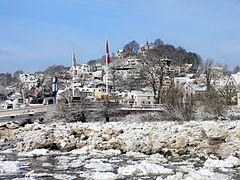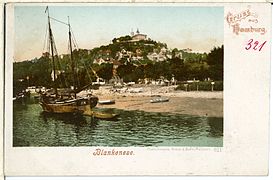Süllberg (Hamburg)
| Süllberg | ||
|---|---|---|
|
View of the Süllberg |
||
| height | 74.6 m | |
| location | Hamburg , Germany | |
| Coordinates | 53 ° 33 '34 " N , 9 ° 48' 4" E | |
|
|
||
The Süllberg (originally "Sollenberge") in the Hamburg district of Blankenese is 74.6 m above sea level. NN one of the highest elevations in the Hanseatic city. Its striking silhouette shapes the public image of the district and is often referred to as Hamburg's local mountain . A castle was built twice on its summit plateau. Today there is a hotel with a restaurant.
Location and description
The Süllberg is part of the Blankeneser Elbe slope and lies around 250 m north of the Elbe beach. The neighboring elevation in the northwest is the Waseberg ( 87 m above sea level ). The summit plateau and the Elbe beach are connected by the so-called stairway quarter , which consists of almost 5000 steps . Structurally, it has grown over several centuries with buildings from different style periods. The development consists mainly of white villas and houses with usually one to three full storeys.
middle Ages
In the 11th century, Adalbert I , the archbishop of Hamburg and Bremen, had the densely wooded Süllberg cleared and a castle built from the wood, which was supposed to secure the ferry connection across the Elbe . It was also a provost built. The castle was destroyed after a short time. In 1258 the Counts of Schauenburg and Holstein , the brothers Johann I and Gerhard I , had a new castle built, also to secure the ferry connection, which was demolished in 1262.
colonization
The Blankeneser Elbhang including the Süllberg is one of the oldest settlement areas in the Hamburg area. Its settlement began in the 16th century. Listed houses from the 18th and 19th centuries still stand in the staircase district, which extends over the slope. The oldest surviving houses date from the first half of the 18th century. They are brick half-timbered buildings with thatched roofs, in particular semi-detached houses for two families (“Tweehuus”) or triple houses for three families (“Dreehuus”). Residential houses in the Biedermeier style from the beginning of the 19th century illustrate the economic boom brought about by shipping.
Catering business
An excursion restaurant has been located on the summit plateau since 1837. At first there was only one milk service. A restaurant was opened around 1840. In 1850 a wooden lookout tower was added. From 1887 the still existing 20 m high stone observation tower and the guest terraces were built. A coach house was built around 1890 . In the period that followed, HADAG put a jetty into operation on the banks of the Elbe near the Süllberg ("Blankenese Süllbergbrücke"). A hotel with ten double rooms was built around 1900. The silhouette that was created in this context was roughly retained until 1994.
In 1990 the summit plateau and the adjacent properties, which had been family-owned for several generations, were sold to the project developer Roland Ernst . He had the catering business closed in 1994 and planned its demolition in order, after initial considerations, to build a congress hotel, and then, according to changed plans, luxury apartments. A citizens' initiative that collected more than 25,000 signatures against the project and organized demonstrations prevented the redesign. In 1998 Ernst sold the project to a real estate fund that drove the revitalization of the Süllberg plateau. After several years of renovation work, a hotel and restaurant were reopened in 2002. In 2010, the Hamburg entrepreneur and former President of the Hamburg Chamber of Commerce, Peter Möhrle, took over the listed building ensemble on the Süllberg. As a Blankenese he felt particularly connected to the place. The owner is the holding company he founded. The restaurant is run by the star chef Karlheinz Hauser .
gallery
Alma del Banco : View of the Elbe from the Süllberg terrace (1918)
See also
literature
- Magrit Schulte-Haubrock, Süllberg-Chronik, The story of a family , reading sample at: http://www.suellberg-chronik.com/suellberg-chronik.php
- Winfried Grützner, Blankenese - A paradise of world renown , Koehlers Verlagsgesellschaft mbH Herford, 1994
- Nicole Tiedemann / Frauke Tietze, Blankenese, a myth , publisher: Altonaer Museum, book accompanying the 2002 exhibition
Web links
- Idyllic prospects: The Süllberg in Hamburg Information from Hamburg Tourismus GmbH - accessed on January 21, 2017
- Stairs quarter - short vacation in Blankenese on hamburg.de - accessed on January 21, 2017
- City district archive - Der Süllberg - accessed on January 21, 2017
- A bird's eye view of Süllberg on YouTube , accessed on January 21, 2017
Individual evidence
- ↑ Bianca Schilling: The best viewpoints in Hamburg. www.merian.de, accessed on January 5, 2017 .
- ↑ a b Gisela Schütte: Final spurt on the Süllberg - the landmark has survived. Die Welt , April 30, 2001, accessed January 21, 2017 .
- ↑ a b c d Tim Holzhäuser: The Süllberg - Blankenese's crown. Hamburger Klönschnack (district magazine), July 9, 2014, accessed on January 21, 2017 .
- ↑ a b c d Alexander Schuller: Gastronomy Süllberg: Mission Berg-Rettung , Hamburger Abendblatt dated November 3, 2012
- ^ Doris Banuscher: One family - 175 years of Süllberg history. Die Welt , August 24, 2012, accessed January 21, 2017 .
- ↑ The new master of Süllberg: We make the house the first address , Hamburger Abendblatt from January 5, 1999
- ^ Matthias Schmook: That will be the new Süllberg , Hamburger Abendblatt from March 6, 1999
- ↑ Judy Brose: The mountain is calling! Storms and falls on the Süllberg , Hamburger Klönschnack (district magazine), June 1999
- ^ Stephan Maaß: Peter Möhrle Holding buys the Süllberg. Die Welt , March 3, 2010, accessed January 25, 2017 .
- ↑ Two men, one mountain. Hamburger Klönschnack (district magazine), April 27, 2010, accessed on January 25, 2017 .







